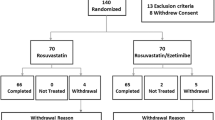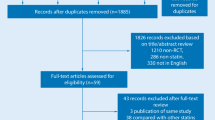Abstract
Objective
To compare the efficacy and tolerability of policosanol with that of fluvastatin in older hypercholesterolaemic women.
Design and Setting
Randomised, single-blind, parallel-group study performed at a single centre in Cuba.
Patients and Participants
70 women aged 60 to 80 years with type II hypercholesterolaemia.
Methods
Patients were randomised after 4 weeks’ dietary stabilisation on a step-one cholesterol-lowering diet to treatment with policosanol (10mg) or fluvastatin (20mg) tablets once daily for 8 weeks.
Results
Policosanol significantly lowered low density lipoprotein cholesterol (LDL-C) [29.2%, p < 0.001], total cholesterol (TC) [19.3%, p <0.001], triglycerides (7%, p < 0.05) and the ratios of LDL-C (39.8%, p < 0.001) and TC (31.6%, p < 0.001) to high density lipoprotein cholesterol (HDL-C), and significantly increased HDL-C (19.8%, p < 0.001). Fluvastatin significantly lowered LDL-C (22.9%, p < 0.001), TC (16.7%, p < 0.001), triglycerides (8.2%, p < 0.05), LDL-C/HDL-C (28.4%, p < 0.001) and TC/HDL-C (22.8%, p < 0.001), and significantly increased HDL-C (9.2%, p < 0.001). Policosanol was more effective than fluvastatin in reducing LDL-C (p < 0.01), TC/HDL-C (p < 0.01) and LDL-C/HDL-C (p < 0.001) as well as in increasing HDL-C (p < 0.01). Policosanol, but not fluvastatin, significantly increased lag time for LDL lipid peroxidation (36.5%, p < 0.001) and significantly decreased the diene peroxidation rate (15.5%, p < 0.05). Both treatments were well tolerated. Five fluvastatin, but no policosanol, recipients discontinued the study, three because of adverse events (chest pain and gastric discomfort, skin rash, and dizziness). Overall, three policosanol and five fluvastatin recipients reported adverse events during the study.
Conclusions
The cholesterol-lowering effects of policosanol 10 mg/day administered for 8 weeks to older women with type II hypercholesterolaemia were slightly better than those of fluvastatin 20 mg/day with respect to the extent of the changes in LDL-C, atherogenic indices and HDL-C levels. In addition, policosanol, but not fluvastatin, significantly inhibited the susceptibility of LDL to undergo lipid peroxidation in this particular study population. Nevertheless, further studies in larger populations and with higher dosages must be conducted to corroborate the present results.





Similar content being viewed by others
References
Anderson KM, Wilson PWF, Odell PM, et al. An updated coronary risk profile. A statement for health professionals. Circulation 1991; 83: 356–62
Lipid Research Clinics Program. The lipid research clinics coronary primary prevention trial results I. Reduction in the incidence of coronary heart disease. JAMA 1984; 251: 351–64
Lipid Research Clinics Program. The lipid research clinics coronary primary prevention trial results II. The relationship of reduction in the incidence of coronary heart disease to cholesterol-lowering. JAMA 1984; 251: 365–74
Scandinavian Simvastatin Survival Study Group. Randomised trial of cholesterol lowering in 4 444 patients with coronary heart disease: the Scandinavian Simvastatin Survival Study (4S). Lancet 1994; 344: 1383–9
Sacks FM, Pfeffer MA, Moy LA, et al., Cholesterol and Recurrent Events Trial Investigators. The effect of pravastatin on coronary events after myocardial infarction in patients with average cholesterol levels. N Engl J Med 1996; 335: 1001–9
Tonkin AM, Hunt D. Long-Term Intervention with Pravastatin in Ischemic Disease (LIPID) Study. Clinical implications for cardiovascular practice. In: Grundy S, editor. Cholesterol-lowering therapy: evaluation of clinical trial evidence. Marcel Dekker, Inc. New York, Basel. 2000: 173–90
Shepherd S, Cobbe SM, Ford I, et al. Prevention of coronary heart disease with pravastatin in men with hypercholesterolemia. N Engl J Med 1995; 333: 1301–7
Expert Panel on Detection, Evaluation and Treatment of High Blood Cholesterol in Adults. Summary of the second report of the National Cholesterol Education Program (NCEP) Expert Panel on Detection, Evaluation, and Treatment of High Blood Cholesterol in Adults (Adult Treatment Panel II). JAMA 1993; 269: 3015–23
Pyorala K, De Backer G, Graham I, et al. on behalf of the Task Force. Prevention of coronary heart disease in clinical practice. Recommendations of the Task Force of the European Society of Cardiology, European Atherosclerosis Society and European Society of Hypertension. Eur Heart J 1994; 15(1): 300–31
Blum CB. Comparison of properties of four inhibitors of 3-hydroxy-3-methylglutaryl-coenzyme A reductase. Am J Cardiol 1994; 73: 3–11D
Garnett WR. The pharmacology of fluvastatin, a new HMG-CoA reductase inhibitors. Clin Cardiol 1994; 17Suppl. 4: 3–19
Parker RA, Clark RW, Sit SY, et al. Selective inhibition of cholesterol synthesis in liver versus extrahepatic tissues by HMG-CoA reductase inhibitors. J Lipid Res 1990; 31: 1271–82
Paternitti J Jr. New drugs for inhibiting cholesterol synthesis experimental studies with fluvastatin. Can J Cardiol 1992; 8Suppl. A: 21–2A
Troendle A. Clinical review of fluvastatin: short-term and long-term data. Clin Cardiol 1994; 17Suppl. 4 IV: 11–5
Davidson MH. FLUENT Investigation group. Fluvastatin long term extension trial (FLUENT): summary of efficacy and safety. Am J Med 1994; 96: 41–4S
Plosker GL, Wagstaff AJ. Fluvastatin: a review of its pharmacology and use in the management of hypercholesterolemia. Drugs 1996; 51(3): 433–59
Baggio G, De Candia O, Forte PL, et al. Efficacy and safety of fluvastatin, a new HMG CoA reductase inhibitor, in elderly hypercholesterolaemic women. Drugs 1994; 47Suppl. 2: 59–63
Laguna A, Magraner J, Arruzazabala ML, et al. Patent Cooperation Treaty EP 937/00007, 05/01/1993
Mas R. Policosanol. Drugs Future 2000; 25: 569–86
Pons P, Rodriguez M, Robaina C, et al. Effects of successive dose increases of policosanol on the lipid profile of patients with type II hypercholesterolemia and tolerability to treatment. Int J Clin Pharmacol Res 1994; XIV: 27–33
Aneiros E, Mas R, Calderón B, et al. Effect of policosanol in lowering-cholesterol levels in patients with type II hypercholesterolemia. Curr Ther Res 1995; 56: 176–82
Canetti M, Morera M, Illnait J, et al. One year study on the effect of policosanol (5 mg-twice-a-day) on lipid profile in patients with type II hypercholesterolemia. Adv Ther 1995; 12: 245–54
Zardoya R, Tula L, Castaño G, et al. Effects of policosanol on hypercholesterolemic patients with disturbances on serum biochemical indicators of hepatic function. Curr Ther Res 1996; 57: 568–77
Benítez M, Romero C, Má R, et al. A comparative study of policosanol versus pravastatin in patients with type II hypercholesterolemia. Curr Ther Res 1997; 58: 859–67
Ortensi G, Gladstein H, Valli H, et al. A comparative study of policosanol versus simvastatin in elderly patients with hypercholesterolemia. Curr Ther Res 1997; 58: 390–401
Más R, Castaño G, Illnait J, et al. Effects of policosanol in patients with type II hypercholesterolemia and additional coronary risk factors. Clin Pharmacol Ther 1999; 65: 6–14
Castaño G, Más R, Fernández JC, Fernández L, et al. Efficacy and tolerability of policosanol compared with lovastatin in patients whit type II hypercholesterolemia and concomitant coronary risk factors. Curr Ther Res 2000; 61: 137–46
Torres O, Agramonte AT, Illnait J, et al. Treatment of hypercholesterolemia in NIDDM with policosanol. Diabetes Care 1995; 18: 393–97
Crespo N, Alvarez R, Más R, et al. Effect of policosanol on patients with non-insulin-dependent diabetes mellitus and hypercholesterolemia: a pilot study. Curr Ther Res 1997; 58: 44–51
Crespo N, Illnait J, Más R, et al. Comparative study of the efficacy and tolerability of policosanol and lovastatin in patients with hypercholesterolemia an non insulin dependent diabetes mellitus. Int J Clin Pharmacol Res 2000; 19(4): 105–16
Menéndez R, Fernández I, Del Rio A, et al. Policosanol inhibits cholesterol biosynthesis and enhances LDL processing in cultured human fibroblasts. Biol Res 1994; 27: 199–203
Menéndez R, Arruzazabala ML, Más R, et al. Cholesterol-lowering effect of policosanol on rabbits with hypercholesterolemia induced by a wheat starch-casein diet. Brit J Nutr 1996; 77: 923–32
Castaño G, Más R, Fernández L, et al. Effect of policosanol on postmenopausal women with type II hypercholesterolemia. Gynecol Endocrinol 2000; 14: 187–95
Castaño G, Más R, Fernández JC, et al. Effect of policosanol in older patients with type II hypercholesterolemia and high coronary risk. J Gerontol 2000; In press
Insull JW, Blach D, Duyoune C, et al. Efficacy and safety of once daily as twice-daily dosing with fluvastatin, a synthetic reductase inhibitor, in primary hypercholesterolemia. Arch Intern Med 1994; 154: 2449–55
Jacotot B, Banga JD, Pfister P, et al. Efficacy of a low dose-range of fluvastatin (XU62-320) in the treatment of primary hypercholesterolaemia. A dose-response study in 431 patients. Br J Clin Pharmacol 1994; 38: 257–63
Betteridge DJ, Durrington PN, Fairhust GJ, et al: Comparison of lipid-lowering effects of lowdose fluvastatin and conventional-dose gemfibrozil in patients with primary hypercholesterolemia. Am J Med 1994 Jun 6; 96: 45S–54S
Illingworth DR, Tobert JA. Areview of clinical trials comparing HMG-CoA reductase inhibitors. Clin Ther 1994; 16(3): 366–85
Illingworth DR, Stein EA, Knopp RH, et al. A randomized multicenter trial comparing the efficacy of simvastatin and fluvastatin. J Cardiovasc Pharmacol Ther 1996; 1(1): 23–30
Ose L, Scott R. Simvastatin-Fluvastatin Study Group. Double-blind comparison of the efficacy and tolerability of simvastatin and fluvastatin in patients with primary hypercholesterolemia. Clin Drug Invest 1995; 10(3): 127–38
Buzzi AP, Pastore MA, Argentine Multicenter Evaluation Investigators. Argentine multicenter evaluation of fluvastatin in the treatment of patients with hypercholesterolemia. Curr Ther Res 1997; 58(12): 1013–28
Jacotot B, Benghozi R, Pfister P, et al: Comparison of fluvastatin versus pravastatin treatment of primary hypercholesterolemia. Am J Cardiol 1995 July 13; 76(2): Suppl. 54–56A
Fernández L, Más R, Illnait J, et al. Policosanol: results of a postmarketing surveillance control on 27 879 cases. Curr Ther Res 1998; 59: 717–22
Más R, Rivas P, Izquierdo JE, et al. Pharmacoepidemiologic study of policosanol. Curr Ther Res 1999; 60: 458–67
Davignon J. The pleiotropic effects of drugs affecting lipid metabolism. In Atherosclerosis. Proceedings of the XIth International Symposium on Atherosclerosis, Paris, 1997, Elsevier, 63–77
Menéndez R, Fraga V, Amor AM, et al. Oral administration of policosanol inhibits in vitro copper ion-induced rat lipo-protein peroxidation. Physiol Behav 1999; 67: 1–7
Menéndez R, Más R, Amor AM, et al. Effects of policosanol on the susceptibility of low density lipoprotein isolated from hypercholesterolemic patients at high coronary risk to in vitro copper-mediated lipid peroxidation: a randomized, double-blind pilot study. Curr Ther Res 2000; 61: 609–20
Hussein O, Schlezinger S, Rosenbest M, et al. Reduced susceptibility of low density lipoprotein (LDL) to lipid peroxidation after fluvastatin therapy no associated with the hypocholesterolemic effect of the drug and its binding to the LDL. Atherosclerosis 1997; 128: 11–8
Leonhardt W, Kurktschen T, Meissner D, et al. Effects of pravastatin therapy on lipids, antioxidants, oxidations of low density lipoproteins and trace metals. Eur J Clin Pharmacol 1992; 53: 65–9
Friedewald WT, Levy RI, Friederickson SD. Estimation of the concentration of low-density-lipoprotein cholesterol in plasma without of the preparative ultracentrifuge. Clin Chem 1972; 18: 499–502
Seigier L, Wu WT. Separation of serum high-density lipoprotein for cholesterol determination: ultracentrifugation vs precipitation with sodium phosphotungstate and magnesium chloride. Clin Chem 1981; 27: 838–41
Kleinveld HA, Hark-Lemmers HLM, Stalenhoef AFH, et al. Improved measurements of low-density lipoprotein susceptibility to copper-induced oxidation: application of a short procedure for isolating low-density lipoprotein. Clin Chem 1992; 38: 2066–72
Esterbauer H, Striegl H, Puhl H, et al. Continuous monitoring of in vitro oxidation of human low density lipoprotein. Free Radic Res Commun 1989; 6: 67–75
Markwell MA, Hass SM, Bieber LL, et al. A modification of the Lowry procedure to simplify protein determination in membrane and lipoprotein samples. Anal Biochem 1987; 87: 206–10
Schectman G, Hiatt J. Drug therapy for hypercholesterolemia in patients with cardiovascular disease: factors limiting achievement of lipid goals. Am J Med 1996; 100: 197–204
Luscher TF, Barton M. Biology of endothelium. Clin Cardiol 1997; 20: II3–II10
Nasr A, Breckwoldt M. Estrogen replacement therapy and cardiovascular protection: lipid mechanism are the tip of an inberz. Gynecol Endocrinol 1998; 12: 43–59
Mijatovic V, Van der Mooren MJ, Stehouwer CDA, et al. Postmenopausal hormone replacement, risk estimators for coronary artery disease and cardiovascular protection. Gynecol Endocrinol 1999; 13: 130–44
Author information
Authors and Affiliations
Rights and permissions
About this article
Cite this article
Fernández, J.C., Más, R., Castaño, G. et al. Comparison of the Efficacy, Safety and Tolerability of Policosanol versus Fluvastatin in Elderly Hypercholesterolaemic Women. Clin. Drug Investig. 21, 103–113 (2001). https://doi.org/10.2165/00044011-200121020-00003
Published:
Issue Date:
DOI: https://doi.org/10.2165/00044011-200121020-00003




